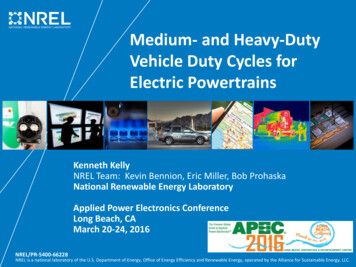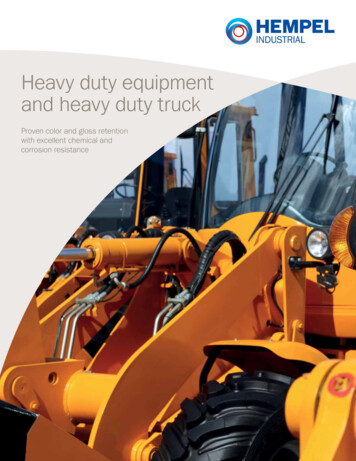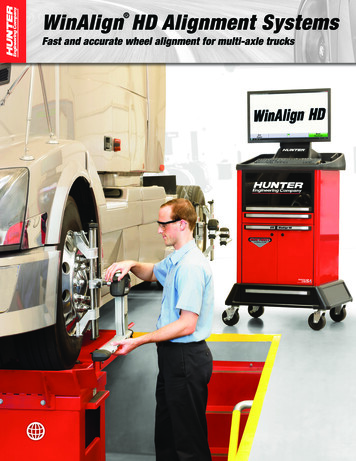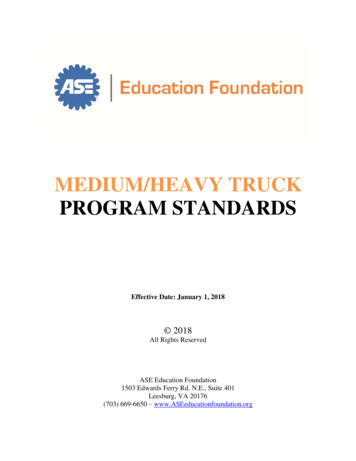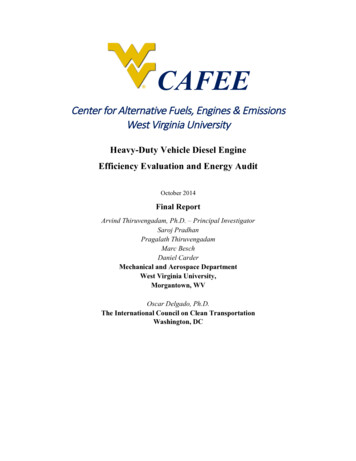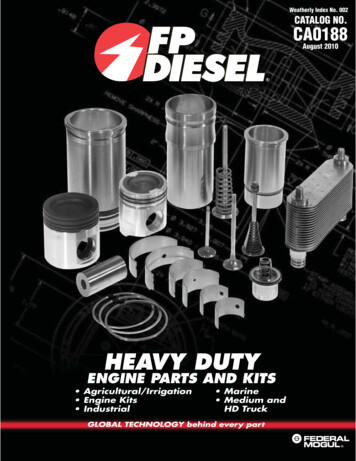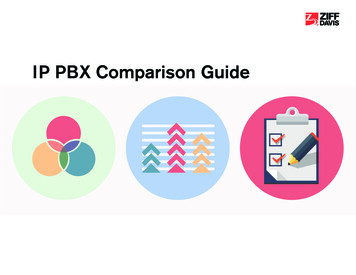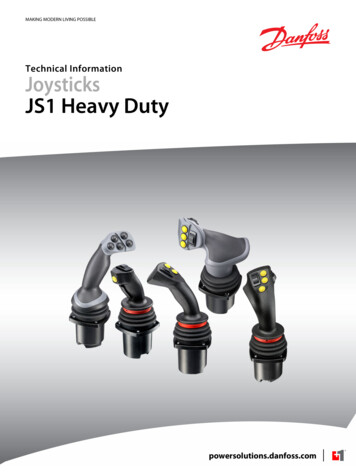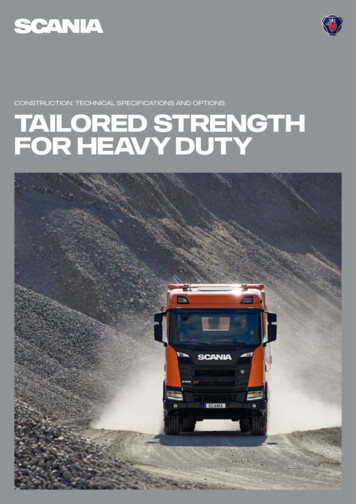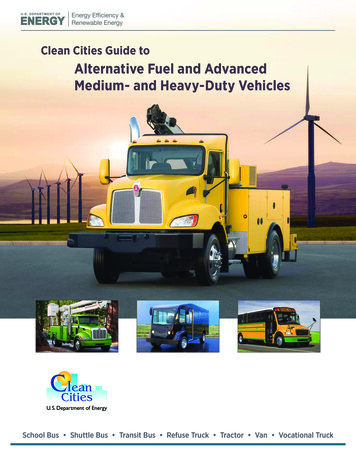
Transcription
Clean Cities Guide toAlternative Fuel and AdvancedMedium- and Heavy-Duty VehiclesSchool Bus Shuttle Bus Transit Bus Refuse Truck Tractor Van Vocational Truck
Clean Cities Guide to Alternative Fuel and Advanced Medium- and Heavy-Duty Vehicles2
Clean Cities Guide to Alternative Fuel and Advanced Medium- and Heavy-Duty VehiclesTable of ContentsAbout the Guide . . . . . . . . . . . . . . . . . . . . . . . . . . . . . . . . . . . . . . . . . . . . . . . . . . . . . . . . . . . . . . . 4Heavy-Duty Vehicle Application Overview . . . . . . . . . . . . . . . . . . . . . . . . . . . . . . . . . . . . . . . . 4Heavy-Duty Emission Standards . . . . . . . . . . . . . . . . . . . . . . . . . . . . . . . . . . . . . . . . . . . . . . . . . 5Multiple-Stage Construction of Medium- and Heavy-Duty Vehicles . . . . . . . . . . . . . . . . . . 6Chassis Selection . . . . . . . . . . . . . . . . . . . . . . . . . . . . . . . . . . . . . . . . . . . . . . . . . . . . . . . . . . . . . . 8Cab Chassis Types . . . . . . . . . . . . . . . . . . . . . . . . . . . . . . . . . . . . . . . . . . . . . . . . . . . . . . . . . . . . . 8Chassis Manufacturers . . . . . . . . . . . . . . . . . . . . . . . . . . . . . . . . . . . . . . . . . . . . . . . . . . . . . . . . . 9Alternative Fuel Engines, Motors, Fuel Cells, and Microturbines . . . . . . . . . . . . . . . . . . . . . . 10Natural Gas Engines . . . . . . . . . . . . . . . . . . . . . . . . . . . . . . . . . . . . . . . . . . . . . . . . . . . . . . 10Propane Engines . . . . . . . . . . . . . . . . . . . . . . . . . . . . . . . . . . . . . . . . . . . . . . . . . . . . . . . . . 10All-Electric . . . . . . . . . . . . . . . . . . . . . . . . . . . . . . . . . . . . . . . . . . . . . . . . . . . . . . . . . . . . . . . 10Fuel Cells . . . . . . . . . . . . . . . . . . . . . . . . . . . . . . . . . . . . . . . . . . . . . . . . . . . . . . . . . . . . . . . . 11Microturbines . . . . . . . . . . . . . . . . . . . . . . . . . . . . . . . . . . . . . . . . . . . . . . . . . . . . . . . . . . . . 11Engines Certified for Biodiesel . . . . . . . . . . . . . . . . . . . . . . . . . . . . . . . . . . . . . . . . . . . . . 11Conversions . . . . . . . . . . . . . . . . . . . . . . . . . . . . . . . . . . . . . . . . . . . . . . . . . . . . . . . . . . . . . . 12Engine, Motor, Fuel Cell, and Microturbine Manufacturers . . . . . . . . . . . . . . . . . . . . . . . . . . . 12Medium- and Heavy-Duty Vehicle Conversion Companies . . . . . . . . . . . . . . . . . . . . . . . . . . 13Hybrid Propulsion Systems by Design . . . . . . . . . . . . . . . . . . . . . . . . . . . . . . . . . . . . . . . . . . . . 14Parallel Hybrid System . . . . . . . . . . . . . . . . . . . . . . . . . . . . . . . . . . . . . . . . . . . . . . . . . . . . 14Series Hybrid System . . . . . . . . . . . . . . . . . . . . . . . . . . . . . . . . . . . . . . . . . . . . . . . . . . . . . 14Parallel Hydraulic Hybrid System (Launch Assist) . . . . . . . . . . . . . . . . . . . . . . . . . . . . . 14Series Hydraulic Hybrid System . . . . . . . . . . . . . . . . . . . . . . . . . . . . . . . . . . . . . . . . . . . . 15Hybrid Propulsion Systems by Fuel . . . . . . . . . . . . . . . . . . . . . . . . . . . . . . . . . . . . . . . . . . . . . . 15Diesel Hybrids . . . . . . . . . . . . . . . . . . . . . . . . . . . . . . . . . . . . . . . . . . . . . . . . . . . . . . . . . . . . 15CNG Hybrids . . . . . . . . . . . . . . . . . . . . . . . . . . . . . . . . . . . . . . . . . . . . . . . . . . . . . . . . . . . . . 15Fuel Cell Hybrids . . . . . . . . . . . . . . . . . . . . . . . . . . . . . . . . . . . . . . . . . . . . . . . . . . . . . . . . . 15Hybrid Propulsion System Manufacturers . . . . . . . . . . . . . . . . . . . . . . . . . . . . . . . . . . . . . . . . . 16Medium- and Heavy-Duty Vehicles by Application . . . . . . . . . . . . . . . . . . . . . . . . . . . . . . . . . 17School Bus . . . . . . . . . . . . . . . . . . . . . . . . . . . . . . . . . . . . . . . . . . . . . . . . . . . . . . . . . . . . . . . 17Shuttle Bus . . . . . . . . . . . . . . . . . . . . . . . . . . . . . . . . . . . . . . . . . . . . . . . . . . . . . . . . . . . . . . 19Transit Bus . . . . . . . . . . . . . . . . . . . . . . . . . . . . . . . . . . . . . . . . . . . . . . . . . . . . . . . . . . . . . . . 22Refuse Truck . . . . . . . . . . . . . . . . . . . . . . . . . . . . . . . . . . . . . . . . . . . . . . . . . . . . . . . . . . . . . 26Tractor . . . . . . . . . . . . . . . . . . . . . . . . . . . . . . . . . . . . . . . . . . . . . . . . . . . . . . . . . . . . . . . . . . 29Van . . . . . . . . . . . . . . . . . . . . . . . . . . . . . . . . . . . . . . . . . . . . . . . . . . . . . . . . . . . . . . . . . . . . . 35Vocational Truck . . . . . . . . . . . . . . . . . . . . . . . . . . . . . . . . . . . . . . . . . . . . . . . . . . . . . . . . . . 37Glossary . . . . . . . . . . . . . . . . . . . . . . . . . . . . . . . . . . . . . . . . . . . . . . . . . . . . . . . . . . . . . . . . . . . . . . 41Photos, from top: North American Bus Industries, Kenworth, Turtle TopFront cover photos, clockwise from top: Kenworth, Thomas Built Buses, Boulder Electric Vehicle, Peterbilt3
Clean Cities Guide to Alternative Fuel and Advanced Medium- and Heavy-Duty VehiclesAbout the GuideToday’s fleets are increasingly interested in medium- and heavy-duty vehicles that use alternative fuels or advancedtechnologies that can help reduce operating costs, meet emissions requirements, improve fleet sustainability, andsupport U.S. energy independence. Vehicle and engine manufacturers are responding to this interest with a widerange of options across a steadily growing number of vehicle applications.This guide provides an overview of alternative fuel power systems—including engines, microturbines, and fuel cells—and hybrid propulsion systems. The guide also offers a brief overview of individual medium- and heavy-duty vehicles,listed by application. Notably, a transition to any alternative fuel or advanced technology is a long-term commitmentthat merits thoughtful research and planning, with attention to technical, economic, and geographical considerations.Clean Cities’ Alternative Fuels Data Center (AFDC) offers a suite of tools that can aid a fleet in its analysis (afdc.energy.gov/tools).Clean Cities collects the vehicle information presented in this guide from multiple sources, including original equipment manufacturers (OEMs), conversion companies, and product literature. Diligent effort was made to contact allmanufacturers that offer commercially available vehicles with alternative fuel or advanced technology options. Manufacturers are also invited to send comments, additions, or corrections related to any information contained in the guideby contacting the AFDC webmaster at afdc.energy.gov/progs/webmaster.php. The AFDC’s online heavy-duty vehicledatabase (afdc.energy.gov/vehicles/search/heavy) reflects product changes made or identified after publication.Heavy-Duty Vehicle Application OverviewThe following list provides an overview of popular alternative fuel and advanced vehicle options for severalcommon applications:SchoolBusCompressed natural gas (CNG) and propane (also known as liquefied petroleum gas, orLPG) are popular alternatives to gasoline and diesel fuel for school buses. Hybrid electricbuses and plug-in hybrid electric buses are also available.ShuttleBusCNG, propane, hybrid electrics, and fuel cells are potential options for shuttle buses andlarge passenger vehicles that provide transportation on standard routes.TransitBusHybrid transit buses, along with those powered by CNG or liquefied natural gas (LNG),are available. Fuel cell demonstrations are also in progress.RefuseTruckMany fleets have refuse trucks with CNG engines, and they can even run on landfill gaswhere biomethane processing facilities are in operation. Regular routes and stop-and-gooperation make refuse haulers a good application for hybrid operation as well. Hydraulichybrid systems are well suited to refuse service.TractorDiesel electric hybrids offer fuel-saving hybrid operation with the convenient availabilityof diesel. CNG and LNG systems are also attractive options.VanVocationalTruck4Step vans that service a set route, such as a package delivery service, may find allelectric battery operation an effective alternative to conventional vans. CNG andpropane operation are also popular alternatives.CNG, LNG, propane, all-electric, and hybrid vehicles operate in a variety of roles, frombeverage delivery to utility boom trucks, paint striping trucks, and merchandise delivery.
Clean Cities Guide to Alternative Fuel and Advanced Medium- and Heavy-Duty VehiclesHeavy-Duty Emission StandardsThe U.S. Environmental Protection Agency (EPA) and theCalifornia Air Resources Board (CARB) regulate vehicleemissions to reduce impacts to public health and the environment. These regulations apply to all vehicles, regardlessof the fuels they operate on.Emission standards are set based upon vehicle weight class.However, the emission certifications for heavy-duty vehiclesapply to the engine rather than to the complete vehicle. Asingle engine can have multiple certifications if it can be usedin vehicles of multiple weight classes. Notably, vehicle weightclassifications vary from one regulatory agency to the next.For more information on emission standards, visit epa.gov/otaq/hd-hwy.htm and arb.ca.gov/msprog/msprog.htm.Vehicle emissions fall into two categories:Engine on a dynamometer at the National RenewableEnergy Laboratory’s ReFUEL facility. Photo by DennisSchroeder, NREL 22781 Air pollutants are smog-forming compounds and other emissions known to or suspected to cause serioushealth and environmental effects. These include particulate matter (PM), non-methane hydrocarbons (NMHC),sulfur oxides (SOx), and nitrogen oxides (NOx). Greenhouse gas (GHG) emissions, primarily carbon dioxide (CO2), contribute to climate change. EPA and theNational Highway Traffic Safety Administration recently adopted GHG emissions regulations for heavy-dutyengines and vehicles.EPA established the following emission limits for heavy-duty engines made after 2009: PM—0.01 grams per brake horsepower-hour (g/bhp-hr) NMHC—0.14 g/bhp-hr NOx—0.20 g/bhp-hr.EPA also regulates the sulfur content in on-highway diesel fuel. Ultra-low sulfur diesel fuel was considered a “technology enabler,” paving the way for advanced, sulfur-intolerant exhaust emission control technologies, such as catalyticdiesel particulate filters and NOx catalysts.PM and NMHC are well controlled by these catalytic filtering systems. NOx may be reduced by the use of exhaust gasrecirculation (EGR) and selective catalytic reduction (SCR).EGR is a NOx emissions reduction process that recirculates a portion of an engine’s exhaust gas back to the enginecombustion chambers. This recirculated gas dilutes the mixture of gases and helps reduce the combustion temperature.Because NOx form primarily at high temperature, the lower combustion temperature results in reduced NOx output.SCR involves injecting a urea-based solution known as diesel exhaust fluid (DEF) into a stream of exhaust gas. Theurea is combined with engine exhaust in the presence of a catalyst to convert smog-forming NOx into nitrogen andwater vapor.Conversion emission standards for heavy-duty vehicles manufactured before 2010 remain the same as the standardsapplicable in the year of engine manufacture. Conversion companies must obtain a certificate of compliance for eachmodel year engine family being converted.5
Clean Cities Guide to Alternative Fuel and Advanced Medium- and Heavy-Duty VehiclesMultiple-Stage Construction of Mediumand Heavy-Duty VehiclesVocational heavy-duty trucks are typically manufactured in multiple stages: An incomplete vehicle or chassis cab isprogressively upfitted with equipment according to the specific tasks the vehicle will perform and is then certifiedas a complete vehicle by a final-stage manufacturer before delivery to the end user. The incomplete vehicle may bemodified, or “manufactured,” by multiple intermediate-stage manufacturers before going to the final-stage manufacturer or may only require a single manufacturing operation by the final-stage manufacturer. The “manufacturing”process performed on the incomplete vehicle by intermediate- or final-stage manufacturers depends on the end-useapplication and the associated specialized equipment requirements, which may include installing equipment, such asrefuse packing bodies, paint-striping systems, snow plows, or aerial platform boom truck bodies, or modifying thechassis (e.g., moving or adding axles or modifying the length of the frame).Because of the vast array of possible final vehicle configurations, and to increase overall flexibility of themanufacturing process, alternative-fuel storage systems (e.g., for CNG, LNG, or propane) may be installed by intermediate- or final-stage manufacturers rather than by the incomplete chassis manufacturer. This may add steps tothe manufacturing process but also allows greater design flexibility. This installation is typically transparent to thevehicle purchaser and is consistent with the multistage manufacturing approach utilized within the market segment.The intermediate- and final-stage manufacturers are typically coordinated by the vehicle dealer, final-stage manufacturer, or equipment manufacturer, depending on the established purchasing arrangements, which may be uniquefor each type of vehicle purchased or for each fleet.Step-by-Step Manufacturing ProcessFour major systems must be integrated into each heavy-duty vocational truck: Chassis Engine Fuel system Specialty equipment.ChassisFor alternative fuel applications, chassis configurations are selected based on end-use requirements in the sameway that conventionally fueled chassis cabs are, except in cases where additional frame length or increased grossvehicle weight rating (GVWR) is required to accommodate a larger and/or heavier fuel storage system. Chassis areavailable in conventional and cab-over-axle configurations based on manufacturers’ decisions about the best designthat will accommodate alternative fuel engines. Cab configurations and frame length are important considerations inchassis selection.EngineChassis are available with OEM alternative-fuel engines, or with gasoline or diesel engines converted to operate onan alternative fuel by installing an emissions-certified conversion system. Alternative fuel engines that run on CNG,LNG, or propane can be dedicated to operate full time on the alternative fuel; bi-fuel to run on either the alternativefuel or gasoline; or dual-fuel to run on the alternative fuel and use diesel for ignition assist. Advanced hybrid vehiclescombine gasoline or diesel engine operation with battery power that reduces petroleum consumption.6
Clean Cities Guide to Alternative Fuel and Advanced Medium- and Heavy-Duty VehiclesFuel SystemCNG, LNG, and propane are stored in cylinders onboard a vehicle. Cylinders are heavier than gasoline or diesel tanksand less flexible in shape—making them more challenging to package on the vehicle. This can result in less volumeor weight capacity for these vehicles when compared to a vehicle with a conventional fuel system. Thoughtful design considerations can compensate for these drawbacks.Specialty equipment manufacturers have recognized the challenges associated with packaging alternative fuel storage systems with sufficient storage capacity and have developed products that seamlessly integrate the alternativefuel system into their product or body structure. In other cases, utility body manufacturers have integrated the fuelsystem into the body equipment to minimize any reductions in fuel storage capacity.Specialty Equipment UpfittingThe final step is upfitting the chassis with the equipment necessary for the desired application, e.g., refuse packer,paint-striping rig, shuttle bus, or beverage delivery hauler.Rooftop CNG Fuel SystemAllows for larger-capacity system but presents overallvehicle height and center-of-gravity challengesBack of Cab CNG Fuel SystemAllows for larger-capacity system butmay increase wheelbase or overalllength of vehicleFrame-Mounted CNG, LNG, or Propane Fuel SystemVehicle wheelbase can be a factor in system capacityIllustration from iStock 9723056, NREL7
Clean Cities Guide to Alternative Fuel and Advanced Medium- and Heavy-Duty VehiclesChassis SelectionA cab chassis is a body style and type of vehicle construction often found in medium-duty commercial vehicles.Instead of a pre-assembled flatbed, cargo container, or other equipment, the customer buys the vehicle with justchassis rails and a cab. This allows the upfitter to assemble any desired aftermarket equipment, such as fire apparatus, an ambulance, beverage truck, or other application-specific equipment.Chassis selection for use with alternative fuels must account for the weight of required fuel tanks or battery packs.The additional weight may reduce cargo space or cargo capacity. In the case of a truck plus a trailer or trailers, thegross vehicle weight as well as the overall length of the vehicle must be within the limits specified by state regulations where the truck or tractor-trailer is to be operated.Cab Chassis TypesConventional CabThe long hood design allows for the power plant to be locatedahead or mostly ahead of the cowl. It may be used on a twoor three-axle chassis. It is best suited to long-distance highwayoperation.Conventional Cab with Set-Back AxleThis is similar to a conventional cab but features a set-back frontaxle for better maneuverability in traffic and better weight transferto the front axle. It may be used on a two- or three-axle chassis.Tilt Cab or Cab Over EngineThis chassis features an extremely short front-bumper-to-back-ofcab dimension. The engine is positioned beneath the cab with aprovision for tilting the cab forward on a pivot to provide access tothe engine. It permits better weight transfer to the front axle andbetter maneuverability compared to conventional cab-forward designs. It is usually used on a three-axle chassis; it can also be usedon a two-axle chassis.Extended CabAn extended cab has additional storage space behind the frontseat for cargo and/or passengers and is longer than a conventionalcab. It is usually used with a two-axle chassis.Crew CabA crew cab features four doors and six-passenger seating. It isused with a two-axle chassis.Source: NTEA8Illustrations from iStock 9723056, NREL
Clean Cities Guide to Alternative Fuel and Advanced Medium- and Heavy-Duty VehiclesChassis Autocar LLCXpeditor ACX, Xpeditor E3,XpertHeavy-duty refuse hauleror vocational truck, mediumduty truckwww.autocartruck.comBlue Bird Corp.All-American Rear Engine,VisionSchool buswww.blue-bird.comCrane CarrierLDT2, LET2, COE2Medium-duty vocational truck,heavy-duty refuse haulerwww.cranecarrier.comFord Motor Co.E-150/250/350/450, F-250/350/450/550/650/750,F-53/59Shuttle bus, vocational truckwww.fleet.ford.com/showroom/environmental vehiclesFreightlinerCustom ChassisMT-45, MT-55Heavy-duty truck,vocational cksBusiness Class M2 106,Plug-In Walk-In VanHybrid vocational truck,bus, walk-in vanwww.freightlinertrucks.comGeneral MotorsChevrolet/GMC 4500CutawayVan, vocational truckwww.gmfleet.comInternationalDurastar, Terrastar, WorkStarMedium-duty and heavy-dutyvocational truck, refuse hauler,over-road uty vocational truck,T270, T370, T440, T470H, T660,heavy-duty hauling, concreteT800, W900mixerwww.kenworth.com/2100 vir.aspMack TrucksTerraPro Cabover,TerraPro Low EntryHeavy-duty refuse hauler,vocational truckwww.macktrucks.com/#/homePeterbilt320, 330 HE, 337 HE, 348 HE,365, 367, 382, 384, 386, 388Medium-duty vocational truck,heavy-duty refuse hauler,concrete mixerwww.peterbilt.com/index.aspxSmith ElectricVehiclesNewton Cab ChassisMedium-duty vocational appliwww.smithelectric.comcations, shuttle bus, school bus9
Clean Cities Guide to Alternative Fuel and Advanced Medium- and Heavy-Duty VehiclesAlternative Fuel Engines, Motors, Fuel Cells, and MicroturbinesNatural Gas EnginesCurrent-production natural gas engines are designed to operate solelyon natural gas (dedicated), on either natural gas or gasoline (bi-fuel), oron a combination of natural gas and diesel fuel (dual-fuel). Dedicatedand bi-fuel natural gas engines are spark-ignited, and dual-fuel enginesutilize a minimal amount of diesel for pilot ignition in compressionignition combustion. Natural gas is stored onboard the vehicle as eitherCNG or LNG. CNG is more common and has a longer history of usein vehicles, but LNG is popular in heavy-duty applications for whichmaximum fuel capacity and extended driving range are required. CNGis stored at pressures of 3,000–3,600 pounds per square inch (psi)in specially designed and constructed cylinders onboard the vehicle.LNG is cooled to a cryogenic temperature of approximately -260 F andstored as a liquid onboard the vehicle in double-wall, vacuum-insulatedstorage tanks.Natural gas is a clean-burning alternative fuel and offers a number ofCummins Westport ISL G natural gas engine.advantages to users. It is colorless, non-corrosive, and odorless, thoughPhoto from Cummins Westoportan odorant is commonly added to aid in leak detection. A switch fromconventional diesel vehicles to natural gas vehicles (NGVs) has the potential to result in lower levels of emissions,including NOx and PM. Additionally, natural gas is generally less expensive than diesel or gasoline.Propane EnginesPropane—also known as liquefied petroleum gas, LPG, or autogas—is a byproduct of crude oil refining and natural gas processing.Propane is a gas at room temperature and is stored onboard avehicle as a liquid in a tank pressurized to about 150 psi.Propane vehicles operate much like gasoline vehicles with sparkignited engines. There are two types of propane fuel-injectionsystems available: vapor and liquid injection. In a vapor-injectionsystem, liquid propane is controlled by a regulator or vaporizer,which converts the liquid to vapor, which is then drawn into thecombustion chamber. In a liquid-injection system, fuel is deliveredto the combustion chamber in liquid form.CleanFUEL USA liquid propane injection system.Photo from CleanFUEL USABecause propane is a low-carbon, clean-burning fuel, a switch topropane has the potential to result in reductions of hydrocarbon,carbon monoxide (CO), NOx , and GHG emissions. In addition, propane is nontoxic, so it isn’t harmful to soil or water when spilled or leaked.All-ElectricAn all-electric vehicle, sometimes called a battery-electric vehicle, is one that uses a battery pack to power an electric motor as its sole source of propulsion. The battery pack is charged by being plugged in. Batteries may be, butare not limited to, lead acid, nickel metal hydride, or lithium ion. Electric vehicles powered by rechargeable batteriesoffer a number of benefits, including reduced noise from the lack of an internal combustion engine (ICE), no gearchanges, and fewer moving parts. The vehicles themselves generate no NOx, SOx, PM, CO2, or CO emissions, thoughemissions are associated with the majority of electricity production in the United States.10
Clean Cities Guide to Alternative Fuel and Advanced Medium- and Heavy-Duty VehiclesFuel CellsFuel cells produce electricity through a chemical reaction—typically between hydrogen and oxygen—with water and heat asbyproducts. In a fuel cell vehicle, the electricity is used to power anelectric motor that drives the vehicle’s wheels. In addition to producing zero tailpipe emissions, hydrogen fuel cells are attractive fortransportation applications for two main reasons: First, hydrogencan be produced from various sustainable and domestic resources;second, fuel cells are more efficient than conventional ICEs in utilizing the chemical energy contained in the fuel. Fuel cells convertroughly 50% of the hydrogen’s energy into electricity.Ballard FCvelocity fuel cell.Photo from Ballard Power SystemsHydrogen storage is one of the major barriers to fuel cell use in vehicles. Hydrogen has a low energy density. To give fuel cell vehiclesan adequate driving range, hydrogen must be stored onboard thevehicles in a gaseous state under very high pressure (e.g., 700 bar), as a cryogenic liquid, or in another medium(e.g., methanol, ethanol, or natural gas) from which hydrogen is extracted through an onboard reformer. Anotheroption is materials-based storage, including chemical hydrides or adsorbents. Several manufacturers are testinghydrogen vehicles and have demonstrated models with the driving ranges required for the consumer market.MicroturbinesA microturbine acts as an auxiliary power unit (APU)in series hybrid vehicles, in applications such as transitbuses or trucks. The microturbine charges the batteries, which in turn power the electric motor that drivesthe wheels of the vehicle. The microturbine can be fueled with natural gas, waste methane, biodiesel, diesel,or propane. A microturbine expands a vehicle’s rangewhile providing added power for auxiliary loads (e.g.,air conditioning and heat), thus reducing engine wear,fuel use, and emissions.Engines Certified for BiodieselBiodiesel or biodiesel blends are used by heavy-dutyMicroturbine. Photo from Capstone Turbine Corp.vehicle operators to reduce petroleum consumptionand pollutant emissions. Biodiesel is a domestic, renewable fuel for diesel engines, which must meet the specifications of ASTM D6751. Biodiesel is produced from vegetable oils, animal fats, or biomass conversion, but it is notthe same as raw vegetable oil.B5 (5% biodiesel, 95% petroleum diesel) can be used in any diesel vehicle. Engine manufacturers may certify theirengines for use with B20 (20% biodiesel, 80% petroleum diesel). Significant reductions of PM, CO, and hydrocarbonemissions can be achieved with B20 blends. Minor impacts in peak torque and fuel economy are related to the lowerenergy density of biodiesel fuels, but thermal efficiency is unchanged. The National Renewable Energy Laboratory’sBiodiesel Handling and Use Guide is a source of more information about biodiesel as a transportation fuel. Find it using the AFDC publications search (afdc.energy.gov/afdc/progs/pubs.php).11
Clean Cities Guide to Alternative Fuel and Advanced Medium- and Heavy-Duty VehiclesConversionsSome fleets may decide to convert their existing conventional vehicles to operate on an alternative fuel. Conversionsof heavy-duty vehicles involve replacing or rebuilding the engine and adding appropriate fuel storage systems.Alternative fuel engines and powertrains are now being packaged by their manufacturers to be a direct replacementfor their diesel counterparts. A Cummins Westport CNG engine, for example, is configured to mount in a chassisjust like a diesel engine does, and an Allison parallel hybrid transmission can mount in the same space as a standardautomatic transmission.Companies that perform alternative fuel conversions must possess EPA or CARB certification that is specific tothe make, model, and model year of the engine in question. The lists of systems certified by EPA and/or CARB areupdated regularly. Visit epa.gov/otaq/consumer/fuels/altfuels/altfuels.htm and arb.ca.gov/msprog/aftermkt/altfuel/altfuel.htm for the most current lists of certified systems for vehicles of all model years.Engine, Motor, Fuel Cell, and Microturbine siteBallard Power SystemsFCvelocity HD6 Fuel CellModule, FCvelocity-9SSLFuel Cell StackHydrogenwww.ballard.comCapstone Turbine Corp.C30, C65, C200, C600,C800, C1000 MicroTurbineNatural gas, propane www.microturbine.comClean Air PowerMaxxForce 13 dual-fuel engineNatural gaswww.cleanairpower.comCummins WestportISL G 8.9L, ISX12 GNatural gaswww.cumminswestport.comDesignLine InternationalECOSaver IVMicroturbinewww.designli
Clean Cities Guide to Alternative Fuel and Advanced Medium- and Heavy-Duty Vehicles 4 About the Guide Today’s fleets are increasingly interested in medium- and heavy-duty vehicles that use alternative fuels or advanced technologies that can help reduce operating costs, meet
